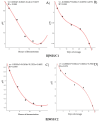Blackberry Juice Fermented with Two Consortia of Lactic Acid Bacteria and Isolated Whey: Physicochemical and Antioxidant Properties during Storage
- PMID: 39201566
- PMCID: PMC11354321
- DOI: 10.3390/ijms25168882
Blackberry Juice Fermented with Two Consortia of Lactic Acid Bacteria and Isolated Whey: Physicochemical and Antioxidant Properties during Storage
Abstract
Fermenting fruit juices with lactic acid bacteria (LAB) is a sustainable method to enhance fruit harvests and extend shelf life. This study focused on blackberries, rich in antioxidants with proven health benefits. In this research, we examined the effects of fermentation (48 h at 37 °C) at 28 days on whey-supplemented (WH, 1:1) blackberry juice (BJ) inoculated with two LAB mixtures. Consortium 1 (BJWH/C1) included Levilactobacillus brevis, Lactiplantibacillus plantarum, and Pediococcus acidilactici, while consortium 2 (BJWH/C2) comprised Lacticaseibacillus casei and Lacticaseibacillus rhamnosus. All of the strains were previously isolated from aguamiel, pulque, and fermented milk. Throughout fermentation and storage, several parameters were evaluated, including pH, lactic acid production, viscosity, stability, reducing sugars, color, total phenolic content, anthocyanins, and antioxidant capacity. Both consortia showed a significant increase in LAB count (29-38%) after 16 h. Sample BJWH/C2 demonstrated the best kinetic characteristics, with high regression coefficients (R2 = 0.97), indicating a strong relationship between lactic acid, pH, and fermentation/storage time. Despite some fluctuations during storage, the minimum LAB count remained at 9.8 log CFU/mL, and lactic acid content increased by 95%, with good storage stability. Notably, sample BJWH/C2 increased the total phenolic content during storage. These findings suggest that adding whey enhances biomass and preserves physicochemical properties during storage.
Keywords: antioxidants; blackberry juice; fermentation; lactic acid bacteria; whey.
Conflict of interest statement
The authors declare no conflicts of interest. The funders had no role in the design of the study; in the collection, analyses, or interpretation of data; in the writing of the manuscript; or in the decision to publish the results.
Figures






Similar articles
-
Biofortification, metabolomic profiling and quantitative analysis of vitamin B12 enrichment in guava juice via lactic acid fermentation using Levilactobacillus brevis strain KU15152.J Sci Food Agric. 2024 Dec;104(15):9191-9201. doi: 10.1002/jsfa.13741. Epub 2024 Jul 16. J Sci Food Agric. 2024. PMID: 39011860
-
Two lactic acid bacteria strains isolated from naturally fermented foods improves physicochemical quality, antioxidant capacity, shelf life stability and metabolic profiles of Dangshan pear (Pyrus spp.) juice.Food Res Int. 2025 Oct;218:116893. doi: 10.1016/j.foodres.2025.116893. Epub 2025 Jun 16. Food Res Int. 2025. PMID: 40790634
-
Volatile profile of elderberry juice: Effect of lactic acid fermentation using L. plantarum, L. rhamnosus and L. casei strains.Food Res Int. 2018 Mar;105:412-422. doi: 10.1016/j.foodres.2017.11.042. Epub 2017 Nov 22. Food Res Int. 2018. PMID: 29433231
-
Fruits and fruit by-products as sources of bioactive compounds. Benefits and trends of lactic acid fermentation in the development of novel fruit-based functional beverages.Food Res Int. 2021 Feb;140:109854. doi: 10.1016/j.foodres.2020.109854. Epub 2020 Oct 28. Food Res Int. 2021. PMID: 33648172 Review.
-
The consequences of fermentation metabolism on the qualitative qualities and biological activity of fermented fruit and vegetable juices.Food Chem X. 2024 Feb 10;21:101209. doi: 10.1016/j.fochx.2024.101209. eCollection 2024 Mar 30. Food Chem X. 2024. PMID: 38384684 Free PMC article. Review.
Cited by
-
Valorization of Dairy By-Products, Sweet Whey, and Acid Whey, in the Production of Fermented Black Carrot Juice: A Comparative Study of the Phytochemical, Physicochemical, Microbiological, and Sensorial Aspects.Foods. 2025 Jan 12;14(2):218. doi: 10.3390/foods14020218. Foods. 2025. PMID: 39856885 Free PMC article.
References
-
- Rastogi Y.R., Thakur R., Thakur P., Mittal A., Chakrabarti S., Siwal S.S., Thakur V.K., Saini R.V., Saini A.K. Food Fermentation—Significance to Public Health and Sustainability Challenges of Modern Diet and Food Systems. Int. J. Food Microbiol. 2022;371:109666. doi: 10.1016/j.ijfoodmicro.2022.109666. - DOI - PubMed
-
- Olvera-Rosales L.B., Pérez-Escalante E., Castañeda-Ovando A., Contreras-López E., Cruz-Guerrero A.E., Regal-López P., Cardelle-Cobas A., González-Olivares L.G. ACE-Inhibitory Activity of Whey Proteins Fractions Derived of Fermentation by Lacticaseibacillus rhamnosus GG and Streptococcus thermophilus SY-102. Foods. 2023;12:2416. doi: 10.3390/foods12122416. - DOI - PMC - PubMed
-
- Duan W., Zhou L., Ren Y., Liu F., Xue Y., Wang F.-Z., Lu R., Zhang X.-J., Shi J.-S., Xu Z.-H., et al. Lactic Acid Fermentation of Goji Berries (Lycium barbarum) Prevents Acute Alcohol Liver Injury and Modulates Gut Microbiota and Metabolites in Mice. Food Funct. 2024;15:1612–1626. doi: 10.1039/D3FO03324D. - DOI - PubMed
MeSH terms
Substances
Grants and funding
LinkOut - more resources
Full Text Sources
Medical
Miscellaneous

